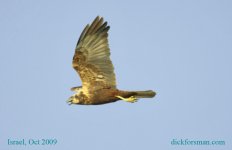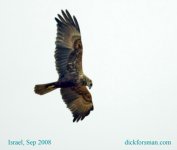JCL
Well-known member
All
Durwyn Liley and I had an odd Marsh Harrier at Sheppey on Thurs pm (4 Nov). The bird was on the Harty Ferry road, in the main raptor area, halfway
between the channel and the Capel Fleet RSPB raptor view point. We only had brief views and I rattled off some distant record shots. the bird then drifted off east. we thought no more about it and bumbled on.
This morning i've had time to look into possibilities and sift the photos.
At http://www.pbase.com/james_lowen/circus, I have posted a series of photos of the bird, all low res, plus one composite image for ease of reference ('ecomposite.jpg). I have also posted
a composite image with the bird in the centre surrounded by images of
EMH, largely taken from Oriental Birding Images
(ecomposite-eastern-with-sheppey-bird-in-middle.jpg; thanks to photographers).
Some thoughts:
UNDERWING
The most striking feature of the Sheppey bird is the extensive whitish
bases to the underprimaries, which contrast with dark secondaries and
restricted black primary tips. Judging from Robson, Fergusson-Lees,
and Brazil, this is a classic feature of juv EMH. I have not been able
to find a single photo of female/juv western marsh harrier (WMH) on
the web with such pale underprimaries and such restricted black
primary tips; that said, JanJ, in a PM, has suggested that WMH can show this. But not all underwing material is spot on: Martin Garner has pointed out that the extensive cream on the axilliaries would be odd for EMH; he moots a second calendar-year MALE WMH.
BREAST BAND
The Sheppey bird also shows an extensive cream breast band, apparently
extending onto the neck. While second calendar-year female WMH can
show this feature, neither Durwyn nor I had ever seen such an extensive
band, and the apparent extension onto the neck is suggestive of EMH,
according to Niall Moores in a v useful Birds Korea web article
(http://www.birdskorea.org/Birds/Identification/ID_Notes/BK-ID-Marsh-Harriers.shtml).
UPPERPARTS
I only got one shot of the Sheppey bird's upperparts, but the
extensive cream on the forewing coverts is striking - and more than I
can ever remember seeing on a WMH. Intriguingly there are hints of
pale tips to the greater coverts (forming a very narrow line); while
juv WMH show this, older females apparently do not, whereas it is
routine on juv EMH. Its very presence suggests that the bird is a
juvenile. If it is, there is far too much cream for WMH, so EMH looks
a live possibility. There is also the vaguest hint of pale feathering
on the rump - which again would be a feature of EMH. Juv EMH's often
show a faintly barred tail, but the photo is too poor to enable me to
judge either way whether this feature is present or absent.
HEAD
The Birds Korea article suggests that head pattern is critical to
distinguish adult/subadult female WMH from juv EMH. Here the photos
are equivocal - but erring towards WMH. There is clearly a dark 'mask'
behind the eye on the ear coverts, which is more likely on WMH.
However, the photo of the upperparts appears to show a cream
demarcation between eye mask and dark neck, which brings EMH back into
play (if the eye mask was continguous with the dark neck, Birds Korea
article suggests that it would mean WMH). I cannot determine, from
photos whether the eye mask extends onto the lores; if it did, this
would again indicate WMH.
STRUCTURE/MOULT
(Eagle-eyed) Martin Garner has suggested that the outer primary (p1) looks rather shorter than would be expected for EMH, where it generally falls level with p5. He muses about whether the bird is moulting, which - i fear - might throw everything up in the air.
CONCLUSION
I suspect this is a WMH, but I keep coming back to those underprimaries... so I would be really grateful if anyone with experience of WMH with such extensive pale underprimaries could post here, or direct me towards photos on the web. Finally, I am aware that EMH and WMH
hybridise, but have no feel for what features hybrids might show.
Another complication!
James
Durwyn Liley and I had an odd Marsh Harrier at Sheppey on Thurs pm (4 Nov). The bird was on the Harty Ferry road, in the main raptor area, halfway
between the channel and the Capel Fleet RSPB raptor view point. We only had brief views and I rattled off some distant record shots. the bird then drifted off east. we thought no more about it and bumbled on.
This morning i've had time to look into possibilities and sift the photos.
At http://www.pbase.com/james_lowen/circus, I have posted a series of photos of the bird, all low res, plus one composite image for ease of reference ('ecomposite.jpg). I have also posted
a composite image with the bird in the centre surrounded by images of
EMH, largely taken from Oriental Birding Images
(ecomposite-eastern-with-sheppey-bird-in-middle.jpg; thanks to photographers).
Some thoughts:
UNDERWING
The most striking feature of the Sheppey bird is the extensive whitish
bases to the underprimaries, which contrast with dark secondaries and
restricted black primary tips. Judging from Robson, Fergusson-Lees,
and Brazil, this is a classic feature of juv EMH. I have not been able
to find a single photo of female/juv western marsh harrier (WMH) on
the web with such pale underprimaries and such restricted black
primary tips; that said, JanJ, in a PM, has suggested that WMH can show this. But not all underwing material is spot on: Martin Garner has pointed out that the extensive cream on the axilliaries would be odd for EMH; he moots a second calendar-year MALE WMH.
BREAST BAND
The Sheppey bird also shows an extensive cream breast band, apparently
extending onto the neck. While second calendar-year female WMH can
show this feature, neither Durwyn nor I had ever seen such an extensive
band, and the apparent extension onto the neck is suggestive of EMH,
according to Niall Moores in a v useful Birds Korea web article
(http://www.birdskorea.org/Birds/Identification/ID_Notes/BK-ID-Marsh-Harriers.shtml).
UPPERPARTS
I only got one shot of the Sheppey bird's upperparts, but the
extensive cream on the forewing coverts is striking - and more than I
can ever remember seeing on a WMH. Intriguingly there are hints of
pale tips to the greater coverts (forming a very narrow line); while
juv WMH show this, older females apparently do not, whereas it is
routine on juv EMH. Its very presence suggests that the bird is a
juvenile. If it is, there is far too much cream for WMH, so EMH looks
a live possibility. There is also the vaguest hint of pale feathering
on the rump - which again would be a feature of EMH. Juv EMH's often
show a faintly barred tail, but the photo is too poor to enable me to
judge either way whether this feature is present or absent.
HEAD
The Birds Korea article suggests that head pattern is critical to
distinguish adult/subadult female WMH from juv EMH. Here the photos
are equivocal - but erring towards WMH. There is clearly a dark 'mask'
behind the eye on the ear coverts, which is more likely on WMH.
However, the photo of the upperparts appears to show a cream
demarcation between eye mask and dark neck, which brings EMH back into
play (if the eye mask was continguous with the dark neck, Birds Korea
article suggests that it would mean WMH). I cannot determine, from
photos whether the eye mask extends onto the lores; if it did, this
would again indicate WMH.
STRUCTURE/MOULT
(Eagle-eyed) Martin Garner has suggested that the outer primary (p1) looks rather shorter than would be expected for EMH, where it generally falls level with p5. He muses about whether the bird is moulting, which - i fear - might throw everything up in the air.
CONCLUSION
I suspect this is a WMH, but I keep coming back to those underprimaries... so I would be really grateful if anyone with experience of WMH with such extensive pale underprimaries could post here, or direct me towards photos on the web. Finally, I am aware that EMH and WMH
hybridise, but have no feel for what features hybrids might show.
Another complication!
James





